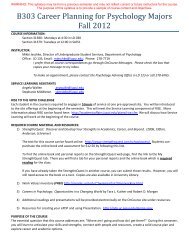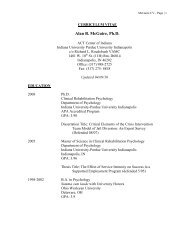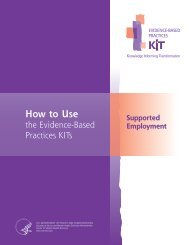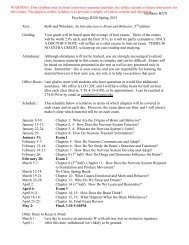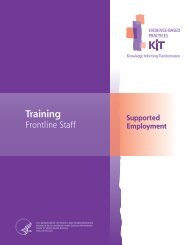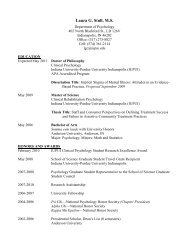Supported Employment: Building Your Program - SAMHSA Store ...
Supported Employment: Building Your Program - SAMHSA Store ...
Supported Employment: Building Your Program - SAMHSA Store ...
- No tags were found...
You also want an ePaper? Increase the reach of your titles
YUMPU automatically turns print PDFs into web optimized ePapers that Google loves.
extensive pre-employment assessment and trainingor intermediate work experiences (like prevocationalwork units, transitional employment positions,or sheltered workshops).How do we know that<strong>Supported</strong> <strong>Employment</strong>is effective?Principle 6: Follow-along supportsare continuousSome consumers struggle with symptoms thatchange or persist over time, so their optimaltreatment and rehabilitation require a long-termcommitment. For this reason, despite theirvocational success, consumers who receive SEservices are never terminated unless they directlyrequest it. Follow-along supports are providedto consumers on a time-unlimited basis.While follow-along supports are continuous,for many consumers the extent of supportgradually decreases over time. In fact, the goalfor employment specialists is to provide supportand assistance while helping consumersbecome independent.Principle 7: Consumer preferencesare importantConsumers who obtain work that they findinteresting tend to have higher levels of satisfactionwith their jobs and longer job tenures. For thisreason, consumers’ preferences guide all phases ofSE services. Honoring consumers’ preferences iscritical in helping them pursue their vocational goals.The SE model has been the most extensivelystudied model of vocational rehabilitation forpeople with serious mental illnesses. Ampleevidence supports its effectiveness. A recent reviewof 17 studies involving employment programsconsistently demonstrated that SE programsshowed significant advantages over traditionalapproaches. Across these studies, 58 percent ofconsumers who were in SE obtained competitiveemployment compared to 21 percent in traditionalprograms (Bond et al., 2001).The SE model has been found to produce bettervocational outcomes than the comparison programs,such as prevocational programming, sheltered work,and transitional employment. Specifically,consumers in SE programs were more successfulin achieving these goals: Obtaining competitive work; Working more hours; and Earning higher wages (Bond et al., 2001).Some research shows that when consumers succeedin finding competitive work, improvements mayoccur in symptoms, self-esteem, and satisfactionwith finances (Bond et al, 2001; Mueser et al.,1997). Most consumers in SE programs who obtainemployment work part-time and are able to keeptheir benefits (i.e., Social Security payments, healthinsurance). Work often becomes a meaningful partof their lives.What Is <strong>Supported</strong> <strong>Employment</strong> 6 <strong>Building</strong> <strong>Your</strong> <strong>Program</strong>



